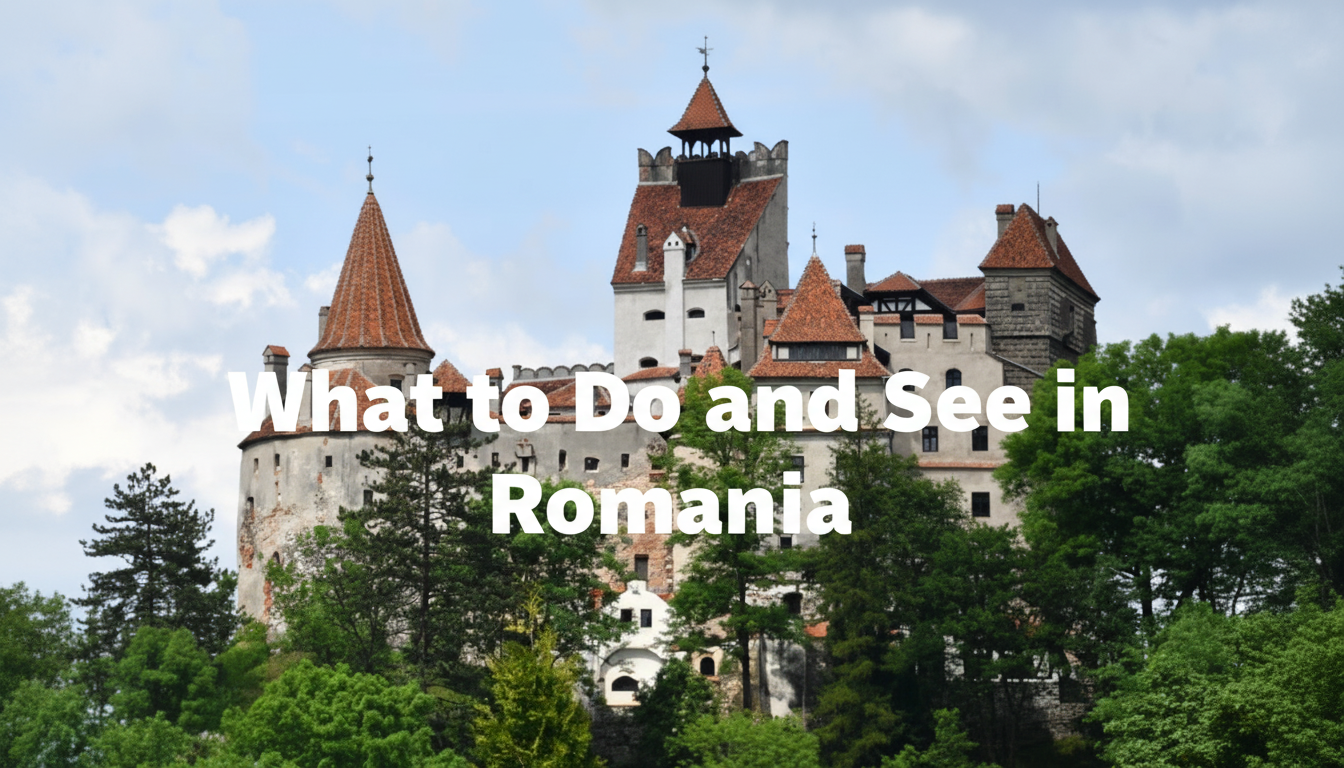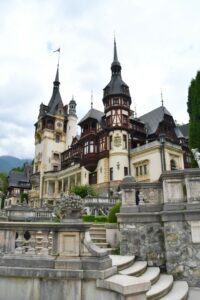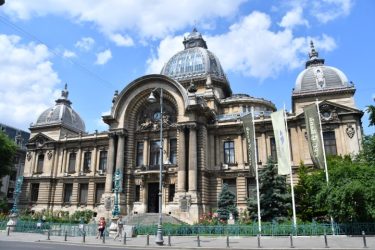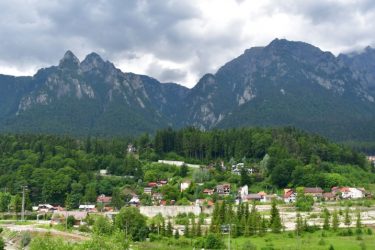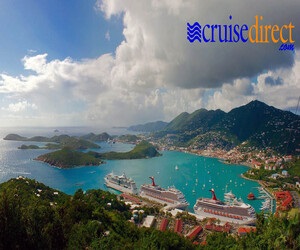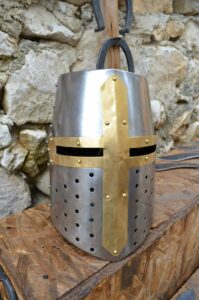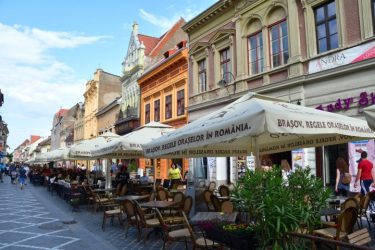Traveling to Romania presents an alluring fusion of diverse cultural experiences, breath-taking natural scenery, and an extensive history. From lively metropolis to tranquil countryside, this jewel of Eastern Europe has much to offer every kind of traveler. It features historic castles and strongholds.
Bucharest: The nation’s capital city is a fantastic place to start. Nicknamed the “Paris of the East,” Bucharest is home to some of the world’s greatest buildings, notably the enormous Palace of the Parliament. The city is a fascinating travel destination because of its active nightlife, unique blend of historical and contemporary attractions, and bustling street scenes.
Transylvania: A trip to Romania wouldn’t be complete without visiting this mythological and legend-filled province. Brașov, a medieval town, offers a distinctive fusion of history and mythology with its quaint old town and close proximity to the renowned Bran Castle (sometimes linked to the Dracula legend). Not far away, two must-see ancient sites are the Sighișoara Citadel, a UNESCO World Heritage site, and the fortified church of Biertan.
Natural Wonders: The striking natural beauty of Romania is not to be missed. The Carpathian Mountains are a great place to go trekking, skiing, and seeing animals. With its spectacular views, the Transfăgărăşan Highway runs through the mountains and is frequently referred to as the world’s best road trip. With its extensive network of lakes, marshes, and rivers, the Danube Delta—another UNESCO World Heritage site—is a sanctuary for avian enthusiasts and lovers of the natural world.
Cultural Heritage: Roman, Hungarian, Turkish, and other civilizations have all left their mark on Romania’s rich and varied culture. The Maramureş and Bucovina regions are home to traditional villages that have wooden churches, painted monasteries, and centuries-old folk traditions. Experiencing these regions offers an insight into the rural lifestyle and rich cultural legacy of the nation.
Romanian wine and cuisine: The country’s diverse cultural heritage and abundant agricultural produce are reflected in the country’s substantial foods such as grilled sausages and sarmale (stuffed cabbage rolls). For a full culinary experience, pair these with regional wines from areas like Dealu Mare or Murfatlar.
Romania is a unique travel destination because of its unique combination of natural beauty, historical intrigue, and cultural diversity. Discovering historic castles, trekking through immaculate mountains, or indulging in the warmth of traditional Romanian hospitality—Romania provides a singular and fascinating travel experience. In this article, we will give you our picks of what to do and see when you visit Romania.
Discover Transylvania in Romania
Central Romania’s Transylvania is a fascinating travel destination renowned for its many cultures, breath-taking scenery, and extensive history. Though this region is frequently linked to the Dracula myth, it has much more to offer than Vlad the Impaler stories. The natural beauty, majestic castles, and well-preserved medieval villages of Transylvania are what make the region so appealing.
Charming medieval towns can be found all over Transylvania’s central region. Brașov is a window into the past of the area, with its colorful Council Square and Gothic Black Church. Sibiu was formerly a European Capital of Culture, renowned for its Baroque architecture and cultural activities. Vlad the Impaler was born in Sighișoara, a UNESCO World Heritage site whose fortress provides a window into medieval times.
Castles and Fortresses: The striking castles and fortresses dot the landscape of Transylvania. Bran Castle, perched majestically atop a hill and frequently associated with the Dracula legend, is a popular tourist destination. One of the biggest castles in Europe, Corvin Castle in Hunedoara, captivates with its Gothic-Renaissance grandeur. The Râşnov Fortress provides sweeping views and historical context for the region’s defensive practices.
Natural Beauty: The ancient sites of Transylvania are beautifully framed by the Carpathian Mountains. Renowned for its breath-taking scenery and winding turns, the Transfăgărășan Highway makes for an unforgettable journey by car. Adventure seekers will find hiking, caving, and animal viewing in Piatra Craiului National Park in the Apuseni Mountains.
Cultural Heritage: Saxon, Hungarian, and Romanian influences are woven throughout Transylvania’s cultural fabric. Its traditional crafts, food, and festivals all showcase this diversity. The region’s Saxon fortified churches, such as those at Biertan and Viscri, have distinctive architectural designs and a long history.
Real Experiences: Traveling through the countryside of Transylvania provides a window into traditional living. Visitors can engage with the local way of life by taking advantage of homestays, local crafts, and gastronomic experiences in villages like Maramureș and the surrounding countryside.
Transylvania is a must-visit location because of its unique combination of natural beauty, cultural diversity, and historical intrigue. Transylvania delivers an enchanted and fascinating experience, regardless of what draws you there—its fabled castles, medieval charm, or breath-taking scenery.
Visit Bucharest in Romania
Romania’s capital, Bucharest, presents a vibrant fusion of modernity, culture, and history. Bucharest, sometimes called the “Paris of the East,” is renowned for its broad boulevards, elegant Belle Époque buildings, and lively street culture. This is a guide to help you explore this intriguing city.
Historical and Architectural Landmarks: The Palace of the Parliament, the second-largest administrative edifice in the world, is one of Bucharest’s most recognizable structures. It is a must-see because of its immense size and lavish furnishings. The city’s rich architectural legacy is on display in the nearby ancient Lipscani area, which features a maze of winding alleyways dotted with medieval, neoclassical, and baroque structures.
Parks and Green Spaces: Bucharest is home to a number of lovely parks that are ideal for leisure and relaxation. Situated around a sizable lake, Herăstrău Park is a great place for boat rides, picnics, and leisurely walks. The oldest park in the city, Cişmigiu Gardens, is a serene haven with meandering walks, a tiny lake, and quaint pavilions.
Museums & Cultural Venues: Exhibiting everything from ancient relics to present history, the National Museum of Romanian History offers a thorough overview of the history of the nation. The Village Museum is an outdoor museum that features a collection of real houses and other structures from different locations, showcasing traditional village life in Romania.
Religious Sites: Beautiful churches and monasteries may be found all over Bucharest. The magnificent frescoes and serene courtyard of Stavropoleos Monastery make it a prime example of Brâncovenesc architecture. Situated atop a hill, the Patriarchal Cathedral provides panoramic views of the city together with spiritual comfort.
Modern Attractions: With its exciting nightlife, hip cafés, and diverse dining options, the city’s modern side is just as alluring. Bucharest’s modern culture may be experienced at the lively bars, clubs, and restaurants that surround Piața Unirii and the Old Town.
Shopping and entertainment: Bucharest has a plethora of options for those who enjoy shopping, ranging from upscale malls to local markets. Two of the biggest malls, AFI Cotroceni and Băneasa Shopping City, provide a variety of national and international brands.
Bucharest is a fascinating place to visit because of its unique blend of modern vitality and historical beauty. Bucharest offers a diverse range of travel experiences, including experiencing its impressive architecture, taking advantage of its green spaces, and immersing yourself in its cultural activities.
Hike and Skiing in the Carpathian Mountains
Romania’s Carpathian Mountains are a magnificent natural wonder that provide a wide variety of outdoor activities, gorgeous scenery, and abundant wildlife. The Carpathians, which cut an arc through the country’s center and east, split Romania into many areas, each with its own special charm and attractions.
Natural Beauty & Landscapes: With their tall peaks, deep forests, and verdant valleys, the Carpathians are well known for their breath-taking landscapes. The southern Carpathians’ Făgăraş Mountains are home to Moldoveanu, Romania’s highest peak at 2,544 meters. Hikers and lovers of the great outdoors will find heaven in its untamed terrain and breath-taking scenery. Retezat National Park, located in the Southern Carpathians, is a great place to go trekking and see wildlife because it has a variety of flora and fauna, including glacial lakes.
Outdoor Activities: Adventure sports and other outdoor activities abound in the Carpathians. Ski resorts with well-kept slopes and contemporary amenities, such as Poiana Brașov and Sinaia, draw skiers and snowboarders in the winter. The mountains become a hotspot for rock climbing, hiking, mountain biking, and paragliding in the summer. Caving and exploring underground rivers and formations are especially popular in the Apuseni Mountains, which are a part of the Western Carpathians.
Historical and Cultural Significance: The Carpathian region has a rich history and culture. Traditional mountainous Romanian villages, like those in Maramureş and Bucovina, provide an insight into rural life and traditions. These regions are well-known for their elaborate crafts, colorful festivals, and wooden cathedrals. The historical aspect of the region’s natural beauty is enhanced by the castles and strongholds, such as Bran Castle and Peleș Castle.
Conservation and Biodiversity: One of Europe’s most important hotspots for biodiversity is the Carpathians. Numerous bird species, bears, wolves, lynxes, and other wildlife can be found in them. In order to guarantee that the natural environment is preserved for future generations, efforts are being made to safeguard these areas through national parks and conservation initiatives.
Romania’s Carpathian Mountains are a paradise for individuals who enjoy the outdoors, seeking adventure, and learning about different cultures. The Carpathians provide a life-changing and remarkable experience, whether you’re hiking up a mountain, skiing down a slope, or just taking in the breath-taking scenery.
Visit the Painted Monasteries of Bucovina
A trip into the past is provided by visiting the Painted Monasteries of Bucovina in Northern Romania, where faith and art combine in a breath-taking exhibition of medieval artistry. These 15th and 16th century monasteries are recognized for their elaborate and colorful exterior frescoes, which have been recognized as UNESCO World Heritage sites.
Historical and artistic significance: Stefan cel Mare, often known as Stephen the Great, and his successors commissioned the Painted Monasteries. In addition to being constructed as houses of worship, they were fortified buildings meant to stave off attacks. The outside and interior walls are covered in frescoes that portray a diverse range of biblical events, saints, and religious narratives. The purpose of these paintings was to use vivid visual narrative to educate the population, which was primarily illiterate.
Key Monasteries:
- The Voroneţ Monastery, also referred to as the “Sistine Chapel of the East,” is well-known for its vivid blue murals, particularly the one depicting the Last Judgment. Because of its persistent vibrancy, art historians are still unable to identify the “Voroneț blue” employed in the works.
- Sucevița Monastery combines Byzantine and Gothic architectural elements; it is well-known for its green tints. One of the most well-known murals in the place depicts the Ladder of Divine Ascent and shows the difficulties encountered en route to Heaven.
- Moldovița Monastery: This monastery is distinguished by its vivid murals in gold and yellow. One famous scenario that features intricate representations of historical events is the Siege of Constantinople.
Cultural Experience: There is a rich spiritual and cultural dimension to visiting these monasteries. These historic sites are set against the bucovina countryside, which features undulating hills and charming villages. The legends and stories told by local guides often enhance visitors’ comprehension of the history and religious legacy of the area, bringing the frescoes to life.
The talent and dedication of the medieval artisans and monks who made the Painted Monasteries of Bucovina are evident. They offer a singular window into Romania’s past, where history, religion, and art are all deeply entwined, and making travel to this area incredibly enlightening.
Explore the Danube Delta in Romania
Discovering the Danube Delta, a UNESCO World Heritage site, is an immersive experience in one of the most beautiful and biodiverse natural settings in all of Europe. The Danube Delta, which is the last section of the river before it joins the Black Sea, is a maze of canals, lakes, marshes, and reed beds that covers an area of more than 4,152 square kilometers.
Biodiversity: With over 300 species of birds, 45 types of freshwater fish, and numerous other animals, the Danube Delta is a nature paradise. Pelicans, herons, cormorants, and numerous more migratory and resident species will captivate birdwatchers. The delta is a photographer’s and nature lover’s dream come true because of its lush, moist environments, which are also home to otters, wildcats, and a variety of reptiles and amphibians.
Distinctive Landscapes: The delta’s topography is a beautiful mix of land and sea. The world’s largest reed beds are a remarkable feature of the landscape and offer a unique environment. A tranquil and attractive setting ideal for boat exploration is created by the lakes and channels, which are frequently bordered with poplars and willows. Stunning vistas can be seen from the constantly shifting interaction of light on the reeds and lake, especially around sunrise and sunset.
Local Culture: For generations, a number of small communities in the delta have continued to live according to their traditional customs. A look into the native way of life may be had in villages like Sfântu Gheorghe and Crișan, where fishing is still a major source of income. In addition to experiencing the kind hospitality of the inhabitants, tourists can savor the cuisine, especially the meals made with fresh fish. Folk music and traditional crafts enhance the region’s cultural diversity.
Activities: By boat is the greatest way to explore the Danube Delta. Guided tours give you the chance to explore the complex system of lakes and channels on short trips or multi-day expeditions. Popular activities that provide a more personal way to discover the delta’s hidden gems are kayaking and canoeing. Sport fishermen can go fishing, and those just want to unwind can just take in the peace and quiet of this pristine natural environment.
The Danube Delta is a must-visit location for nature enthusiasts and those looking for an adventure off the beaten route because of its incredible biodiversity, distinctive landscapes, and rich cultural legacy. The delta provides an amazing experience, whether you choose to go birdwatching, explore by boat, or become fully immersed in the native way of life.
Experience Maramureș in Romania
Discovering Maramureș, an area located in northern Romania, provides an unparalleled opportunity to engage with authentic Romanian culture, since customs and traditions have been conserved for generations. Many refer to Maramureş as Romania’s “living museum” because of its rich cultural legacy, wood-built churches, and gorgeous scenery.
Maramureş is well-known for its wood churches, eight of which are included as UNESCO World Heritage Sites. Constructed throughout the 17th and 18th centuries, these churches exhibit remarkable workmanship due to their elaborate wood carvings and tall, thin spires. The Church of Saint Nicholas in Budești and the Church of the Presentation of the Virgin at the Temple in Bârsana are two notable examples. Not only are these churches important architectural landmarks, but they are also important spiritual hubs that have greatly impacted the neighborhood.
Traditional Villages: The Maramureş villages, including Breb, Botiza, and Ieud, have managed to hold on to their customs. Tourists can watch people employing ancient methods for weaving, woodworking, and farming—all age-old crafts. A genuine taste of country living can be had by booking a room at a nearby guesthouse, where the famed kindness of the peasants is felt. Folk music and dance are frequently featured at traditional festivals and festivities, which provide an opportunity to learn about the rich cultural traditions of the area.
One of Maramureş’s most distinctive sights is the Merry Cemetery, which is situated in the village of Săpânța. Unlike regular cemeteries, the Merry Cemetery has whimsical epitaphs that honour the lives of the departed together with vividly coloured wooden crosses decorated with naive-style paintings. Visitors will find this upbeat approach to death and remembering to be both heart-breaking and uplifting.
Maramureş has a variety of scenic landscapes, including thick forests, beautiful meadows, and rolling hills. The area is ideal for outdoor pursuits like horse-drawn carriage trips, hiking, and cycling. The Mocănița, a narrow-gauge steam train, travels through some of the most secluded and picturesque regions in the region, providing stunning views as it descends into the Vaser Valley.
Customary Arts & Crafts: The area is well known for its handcrafted textiles, pottery, and wood carvings. Visit local markets and workshops to see the creation of these crafts and buy one-of-a-kind, handcrafted trinkets. These traditional artefacts are of excellent quality and have elaborate designs that demonstrate the craftsmanship that has been passed down through the years.
Traveling to Maramureş is similar to traveling through time. Travelers can enjoy a really authentic and enriching experience at this place where the past and present coexist together due to its preserved traditions, stunning landscapes, and kind hospitality.
Relax on the Black Sea Coast in Romania
Unwinding on Romania’s Black Sea Coast offers the ideal fusion of beach, sea, and cultural discovery. The Romanian coast, which stretches along the nation’s eastern border, is known for its stunning beaches, ancient cities, and lively coastal culture.
Beaches: The Black Sea Coast is a great place to sunbathe, swim, and enjoy water sports because of its sandy beaches and crystal-clear waters. Known beach resorts with a variety of facilities, such as beachside eateries and water sport rentals, are Mamaia, Constanta, Eforie Nord, and Mangalia.
Historical Sites: The coast has a rich past, with traces left by long-gone civilizations. Visit the ancient Constanta Casino, a famous Art Nouveau monument, and the Roman Mosaic Edifice, one of the largest of its kind in Eastern Europe. There are Greek and Roman-era archaeological remains at the nearby ancient city of Histria.
Experiences with Culture: Dive into the dynamic local way of life with regional specialties, seafood dishes, and bustling marketplaces. Throughout the summer, the seaside towns come alive with festivals, concerts, and events that give visitors a chance to experience Romanian tradition, music, and dance.
Danube Delta Excursions: Visit the Danube Delta, where the river meets the sea, by boat for a really unforgettable experience. Renowned for its biodiversity, peaceful natural beauty, and birdwatching opportunities, this UNESCO World Heritage site is well-known.
Outdoor Activities: The Black Sea Coast provides hiking, cycling, and nature reserve exploration beyond the beaches, including the Comana Natural Park and the Dobrogea Gorges.
Local Hospitality: Family-run guesthouses, waterfront cafes selling fresh seafood, and a kind greeting that makes guests feel at home are just a few examples of how Romanian hospitality is best displayed along the coast.
The Black Sea Coast of Romania offers a wide variety of activities and attractions to suit any traveler’s taste, making it the perfect place to mix leisure with adventure. The coast offers an amazing experience whether you’re looking for an outdoor adventure, a sun-drenched beach vacation, or a cultural immersion.
Visit Brasov in Romania
The medieval-style city of Brașov, Romania, is tucked away in the heart of Transylvania and has a rich history. It is surrounded by beautiful scenery. The following highlights Brașov’s appeal as a travel destination:
Historical Heritage: Brașov, which was established in the thirteenth century by the Teutonic Knights, has a beautiful medieval city complete with defensive walls, winding cobblestone lanes, and Gothic buildings. Notable for its burnt exterior following a fire, the Black Church (Biserica Neagră) commands a striking view of the cityscape and is home to large collections of religious and historical relics.
Piata Sfatului: Brașov’s central plaza is a hive of activity encircled by vibrant baroque structures, eateries, and cafes. It’s a great place to unwind, people-watch, and take in the stunning Baroque-style Council House (Casa Sfatului), which represents the independence and authority of the city.
Outdoor Activities: Brașov is a great place for outdoor enthusiasts to get access to the Carpathian Mountains. Poiana Brașov, a nearby ski resort, is a popular destination in the winter, and hikers and mountain bikers are welcome to explore the surrounding trails and forests during the warmer months.
Cultural Scene: The city holds a number of annual cultural events, including as the international film festival and marketplace, Brasov International Film Festival & Market (BIFF). For an understanding of local art and history, visit the First Romanian School Museum and the Art Museum of Brasov.
Bran Castle: Frequently linked to the Count Dracula tale, Bran Castle is located not far from Brașov. The castle itself is a wonderful example of medieval construction and provides breath-taking views of the surrounding countryside, despite its shaky connection to Vlad the Impaler.
History enthusiasts, outdoor enthusiasts, and anybody looking to experience the allure of Transylvania will find Brașov’s blend of historical sites, scenic beauty, and vibrant culture to be an unmissable destination in Romania.
9. Festivals in Romania
Numerous festivals are held in Romania all year long, each providing a special window into the nation’s vibrant customs and rich cultural tapestry. These events, which feature everything from food and folklore to music and dance, honour Romania’s rich cultural legacy and provide both locals and tourists unforgettable experiences.
George Enescu Festival: One of the most prominent classical music festivals in Eastern Europe, the George Enescu Festival takes place in Bucharest every two years. The festival, named for the well-known Romanian composer George Enescu, brings together world-class musicians and music lovers with its symphonic concerts, chamber music performances, and opera productions.
The Sighișoara Medieval Festival takes guests to the Middle Ages and is held in the UNESCO-listed town of Sighișoara. There will be historical music and dance performances, traditional crafts, knight competitions, and medieval re-enactments. Sighișoara’s medieval architecture serves as the setting for this vibrant celebration of history and culture.
Romania’s biggest and most esteemed film festival is called Transylvania International Film Festival (TIFF), and it takes place in Cluj-Napoca every year. It presents a wide range of foreign and Romanian motion pictures, including feature films, documentaries, and shorts. Filmmakers and other industry professionals can network at TIFF through seminars, panel talks, and other activities.
The community of Rosia Montana, which is well-known for its rich mining history and cultural legacy, is the site of the inaugural Rosia Montana International Film Festival. Through film screenings, seminars, and conversations, the event highlights local and global perspectives on sustainability and community engagement with a focus on environmental challenges and social justice.
Dragobete: A traditional love celebration in Romania observed on February 24th, Dragobete is akin to Valentine’s Day. Young couples celebrate their love for one another with flower-picking, dancing, and other activities that are said to bring luck and prosperity in relationships.
The country’s customs, culture, and artistic manifestations may all be fully experienced during Romania’s festivals, which are a delightful complement to any travel plan.




